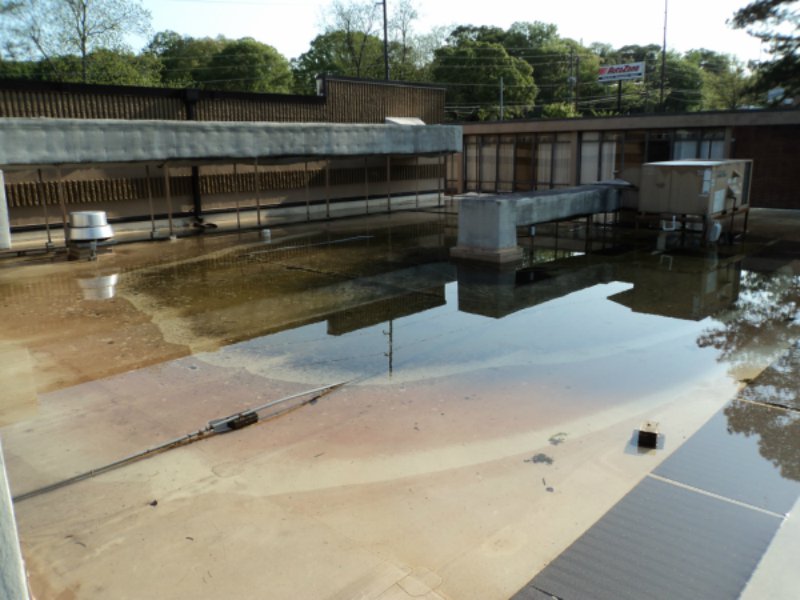For Statewide, no two commercial roofing jobs are the same.
But there are issues that we see again and again, one of them being the problem of ponding water on a flat roof and the best way for business owners to deal with it.
Commonly used on outbuildings and large warehouses, as well as other business properties, flat roofs have advantages over pitched roofs. There are fewer damage and repair costs over the lifespan of the roof. Air conditioning units, solar panels and other equipment can be put on the roof instead of the ground.
Flat roofs are usually cheaper to install than sloped roofs, but they require more maintenance to make sure seals remain watertight. If water settles in one spot on your roof, it will cause considerable damage over time.
What is Ponding?
Roof systems are not designed to hold water. Most roof warranties have something about how a building owner is required to maintain positive drainage. If you allow water to pond on a roof for 48 hours under dry conditions, your warranty may be void.
Of course, no roof is ever really flat. A more appropriate name is “low-slope” roof, because even flat roofs have a slight slope to encourage positive drainage. Still, after heavy rains or snow, pools of water can form on flat roofs. Ponding water is typically a sign of a drainage problem that you need to address before it creates problems. Positive drainage is a rooof maintenance priority that should not be taken for granted.
Does Ponding Cause Roof Damage?
Ponding can create a few problems for you and your roof. Standing water can collect dirt, which can send mud into leaks into your home. It can even cause moss and other vegetation to grow. Ponding can even attract insects.
Standing water can act like a magnifying glass in sunlight, increasing the damaging ultraviolet exposure to your shingles. Water can cause “photo-oxidation” (i.e. premature deterioration) of the roof membrane, flashings and coatings. It can also break down the adhesives used to make field-fabricated single-ply laps, compromising the integrity of the roof system.
The result? Structural damage to the building up to and including a roof collapse.
How To Detect Ponding Water Issues
Check your roof for obvious signs of clogged gutters and drains. If your roof has drain pipes, make sure they aren’t blocked and that water is properly routing routing away from the roof. If you’re lucky, a blockage caused by tree branches or leaves that can be easily removed is all you have to deal with.
Leaks are going to become the most obvious signs of a problem. Unfortunately, leaks are sometimes hard to detect. Some roofing materials don’t always readily show damage, particularly tar and gravel.
Your first clue will probably be wet spots on your ceiling or walls. Check every inch of your ceilings.
If that doesn’t solve the problem, contact a qualified commercial and residential roof replacement professional who can quickly diagnose the problem and take care of it before it grows into a bigger, more costly issue.
You can try a roof coating product on your flat roof to protect from ponding. For example, silicone roof coatings and acrylic coating scan withstand ponding water for quite a while if applied properly. These coatings form a new, seamless, fully adhered protective membrane on top of the roof’s substrate. They’re not an ideal solution to leaks, but they can buy you a few years if you’re putting off roof replacement.
Statewide Construction LLC offers a high level of value and customer service to businesses and homeowners. We offer top quality roofing products, professional installation, friendly and prompt customer service. Check out our reviews! As a Licensed General Contractor, we are one of the most reputable and respected roofing contractors in North Carolina.
ponding water image courtesy of Mid-South Roof Systems
